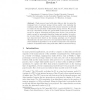Free Online Productivity Tools
i2Speak
i2Symbol
i2OCR
iTex2Img
iWeb2Print
iWeb2Shot
i2Type
iPdf2Split
iPdf2Merge
i2Bopomofo
i2Arabic
i2Style
i2Image
i2PDF
iLatex2Rtf
Sci2ools
109
Voted
WEA
2009
Springer
2009
Springer
On Computational Models for Flash Memory Devices
Flash memory-based solid-state disks are fast becoming the dominant form of end-user storage devices, partly even replacing the traditional hard-disks. Existing two-level memory hierarchy models fail to realize the full potential of flash-based storage devices. We propose two new computation models, the general flash model and the unit-cost model, for memory hierarchies involving these devices. Our models are simple enough for meaningful algorithm design and analysis. In particular, we show that a broad range of existing external-memory algorithms and data structures based on the merging paradigm can be adapted efficiently into the unit-cost model. Our experiments show that the theoretical analysis of algorithms on our models corresponds to the empirical behavior of algorithms when using solid-state disks as external memory.
Related Content
| Added | 27 Jul 2010 |
| Updated | 27 Jul 2010 |
| Type | Conference |
| Year | 2009 |
| Where | WEA |
| Authors | Deepak Ajwani, Andreas Beckmann, Riko Jacob, Ulrich Meyer, Gabriel Moruz |
Comments (0)

